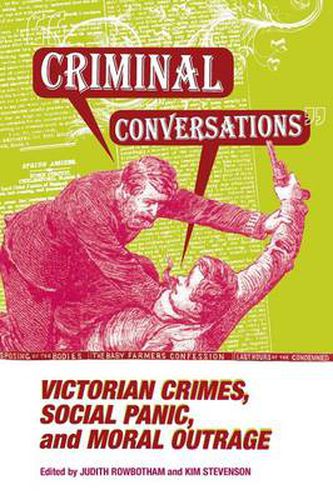Readings Newsletter
Become a Readings Member to make your shopping experience even easier.
Sign in or sign up for free!
You’re not far away from qualifying for FREE standard shipping within Australia
You’ve qualified for FREE standard shipping within Australia
The cart is loading…






This title is printed to order. This book may have been self-published. If so, we cannot guarantee the quality of the content. In the main most books will have gone through the editing process however some may not. We therefore suggest that you be aware of this before ordering this book. If in doubt check either the author or publisher’s details as we are unable to accept any returns unless they are faulty. Please contact us if you have any questions.
In the climate of social panics that characterized so much of the Victorian period, there was keen consciousness of the threats a variety of crimes posed to social stability. Conversations about crime, particularly via the media, were a major feature of Victorian Britain’s daily life, and it was through such conversations that people learned about the nature of crime and criminality, as well as about the individuals who committed crimes or were merely guilty of socially offensive conduct or bad behavior. The essays in this book set out to explore the ways in which Victorians used newspapers to identify the causes of bad behavior and its impacts, and the ways in which they tried to distance criminals and those guilty of bad behavior from the ordinary members of society, including identification of them as different according to race or sexual orientation. It also explores how threats from within normal society were depicted and the panic that issues like baby-farming caused. Victorian alarm was about crimes and bad behavior which they saw as new or unique to their period-but which were not new then and which, in slightly different dress, are still causing panic today. What is striking about the essays in this collection are the ways they echo contemporary concerns about crime and bad behavior, including panics about new types of crime. This has implications for modern understandings of how society needs to understand crime, demonstrating that while there are changes over time, there are also important continuities. Judith Rowbotham is senior lecturer in history, Nottingham Trent University. Kim Stevenson is senior lecturer in law at the University of Plymouth. Rowbotham and Stevenson are founders and directors of SOLON: Promoting Interdisciplinary Studies in Bad Behavior and Crime.
$9.00 standard shipping within Australia
FREE standard shipping within Australia for orders over $100.00
Express & International shipping calculated at checkout
This title is printed to order. This book may have been self-published. If so, we cannot guarantee the quality of the content. In the main most books will have gone through the editing process however some may not. We therefore suggest that you be aware of this before ordering this book. If in doubt check either the author or publisher’s details as we are unable to accept any returns unless they are faulty. Please contact us if you have any questions.
In the climate of social panics that characterized so much of the Victorian period, there was keen consciousness of the threats a variety of crimes posed to social stability. Conversations about crime, particularly via the media, were a major feature of Victorian Britain’s daily life, and it was through such conversations that people learned about the nature of crime and criminality, as well as about the individuals who committed crimes or were merely guilty of socially offensive conduct or bad behavior. The essays in this book set out to explore the ways in which Victorians used newspapers to identify the causes of bad behavior and its impacts, and the ways in which they tried to distance criminals and those guilty of bad behavior from the ordinary members of society, including identification of them as different according to race or sexual orientation. It also explores how threats from within normal society were depicted and the panic that issues like baby-farming caused. Victorian alarm was about crimes and bad behavior which they saw as new or unique to their period-but which were not new then and which, in slightly different dress, are still causing panic today. What is striking about the essays in this collection are the ways they echo contemporary concerns about crime and bad behavior, including panics about new types of crime. This has implications for modern understandings of how society needs to understand crime, demonstrating that while there are changes over time, there are also important continuities. Judith Rowbotham is senior lecturer in history, Nottingham Trent University. Kim Stevenson is senior lecturer in law at the University of Plymouth. Rowbotham and Stevenson are founders and directors of SOLON: Promoting Interdisciplinary Studies in Bad Behavior and Crime.